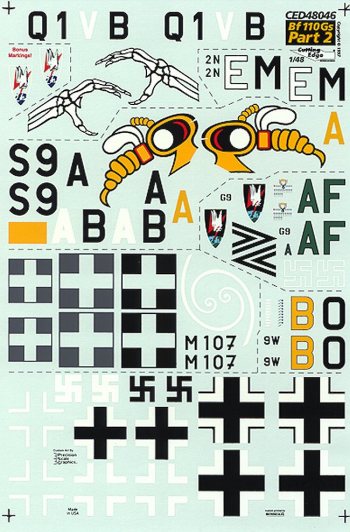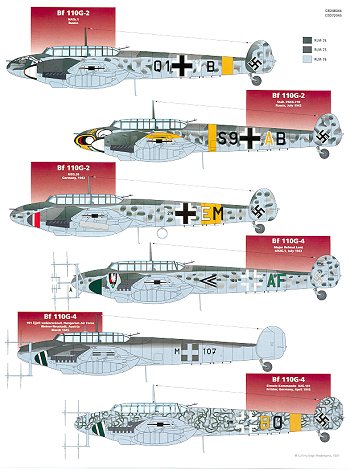|
Sheet # |
Cutting
Edge 48-046 for Bf-110G-2/4 |
|
Price: |
$9 |
|
Units: |
See review |
|
Review By: |
Scott Van Aken |
|
Notes: |
For Revell 1/48
Bf-110G-2/4 kits |
 The Messerschmitt Bf-110 was one of those
planes built to a specification that looked great on paper, but ended up being a
real flop. Just before the war, the concept of the twin-engined heavy fighter
was one that was embraced by a number of countries around the world. Other than
perhaps Japan, no one embraced the concept more than the Luftwaffe. From the
original requirement came not only the Bf-110, but also the Me-210 and 410.
These aircraft were built in rather large numbers, and while all but the 210 did
eventually become useful aircraft, it was not as a heavy fighter.
The Messerschmitt Bf-110 was one of those
planes built to a specification that looked great on paper, but ended up being a
real flop. Just before the war, the concept of the twin-engined heavy fighter
was one that was embraced by a number of countries around the world. Other than
perhaps Japan, no one embraced the concept more than the Luftwaffe. From the
original requirement came not only the Bf-110, but also the Me-210 and 410.
These aircraft were built in rather large numbers, and while all but the 210 did
eventually become useful aircraft, it was not as a heavy fighter.
The heavy fighter
was a design that was supposed to be able to use its heavier firepower to
overwhelm enemy bombers, and yet still be good enough to act as escorts for
their own bomber aircraft. Well, somewhere along the line, the planners
overlooked the fact that a large, multi-engined, multi-place aircraft
usually will not do well against a single seat, single engined fighter.
And that is what was
discovered, much to the dismay of the Luftwaffe. While the 110 did quite well
against light opposition or obsolescent aircraft, when it was finally pit
against modern fighters it was found to be woefully inadequate to the task. This
unhappy discovery came when the Luftwaffe really needed long-range bomber
escorts and then found that they didn't have them. The 110s spent most of their
combat time either being shot to pieces or defending themselves. This left the
bombers to the mercy of the defending fighters.
Despite this the 110
was developed as it was found to be an excellent aircraft for ground attack in
areas where there was little opposition or where it has fighter escort. It also
made a very stable and reliable night fighter. As such, it was used until the
final days of the war.
The later models
were the G series with improved engines and more robust airframes.
 Cutting Edge has provided us with six schemes
for these late model Bf-110s. The first four are painted in variations of RLM
74/75 upper and RLM 76 lower surfaces. The fifth only has an RLM 75 upper
surface while the last one is in overall RLM 76 with 74/75 squiggles all over
it.
Cutting Edge has provided us with six schemes
for these late model Bf-110s. The first four are painted in variations of RLM
74/75 upper and RLM 76 lower surfaces. The fifth only has an RLM 75 upper
surface while the last one is in overall RLM 76 with 74/75 squiggles all over
it.
The first aircraft
is a G-2 variant with NaGr 1 in Russia. This aircraft has only the yellow
Eastern Front fuselage band. What makes it interesting is the skeletal hand
marking on the nose. This is similar to the marking I used on my Ju-88A-14 kit.
Next is another G-2
from Stab I/kg.210, again in Russia, around July 1942. This one is in full
Eastern Front markings and includes the large 'Wespen' or Wasp design on the
nose.
The third G-2 is
from III/ZG.76 based in Germany in 1943. Nothing really special about the
markings, but this one is carrying the rocket tubes under the wing. This weapon
had some success against bombers.
The first G-4 night
fighter is the aircraft of Maj. Helmut Lent, one of the night fighter aces.
While the instructions said there was a smaller correction sheet for this
aircraft, one was not in with my decals.
Second G-4 is a
Hungarian one in a very plain and subdued set of markings. Sort of Lo-Viz 1945.
Finally a G-4 in my
favourite camo scheme; that with lots of squiggles! This is from NJG 101 over
Germany in late 1945.
All in all, six
really neat schemes for your Revell Bf-110G
Review copy courtesy
of me and my now empty wallet!
If you would like your product reviewed fairly and quickly by a
site that has over 1,100 visits a day, please contact
me or see other details in the Note to Contributors.
 The Messerschmitt Bf-110 was one of those
planes built to a specification that looked great on paper, but ended up being a
real flop. Just before the war, the concept of the twin-engined heavy fighter
was one that was embraced by a number of countries around the world. Other than
perhaps Japan, no one embraced the concept more than the Luftwaffe. From the
original requirement came not only the Bf-110, but also the Me-210 and 410.
These aircraft were built in rather large numbers, and while all but the 210 did
eventually become useful aircraft, it was not as a heavy fighter.
The Messerschmitt Bf-110 was one of those
planes built to a specification that looked great on paper, but ended up being a
real flop. Just before the war, the concept of the twin-engined heavy fighter
was one that was embraced by a number of countries around the world. Other than
perhaps Japan, no one embraced the concept more than the Luftwaffe. From the
original requirement came not only the Bf-110, but also the Me-210 and 410.
These aircraft were built in rather large numbers, and while all but the 210 did
eventually become useful aircraft, it was not as a heavy fighter. Cutting Edge has provided us with six schemes
for these late model Bf-110s. The first four are painted in variations of RLM
74/75 upper and RLM 76 lower surfaces. The fifth only has an RLM 75 upper
surface while the last one is in overall RLM 76 with 74/75 squiggles all over
it.
Cutting Edge has provided us with six schemes
for these late model Bf-110s. The first four are painted in variations of RLM
74/75 upper and RLM 76 lower surfaces. The fifth only has an RLM 75 upper
surface while the last one is in overall RLM 76 with 74/75 squiggles all over
it.